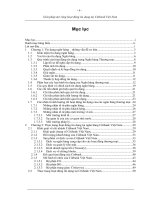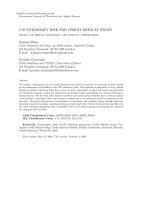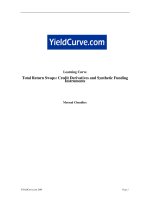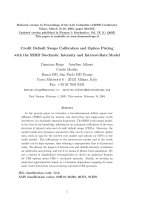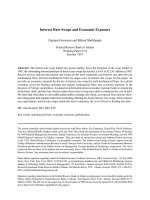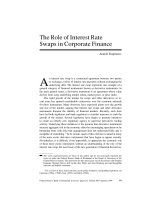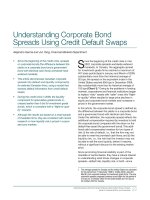Citibank swaps
Bạn đang xem bản rút gọn của tài liệu. Xem và tải ngay bản đầy đủ của tài liệu tại đây (871.15 KB, 146 trang )
Swaps
December 1999
Swaps
Warning
This workbook is the product of, and
copyrighted by, Citicorp North America, Inc. It
is solely for the internal use of Citicorp North
America, Inc. and may not be used for any
other purpose. It is unlawful to reproduce the
contents of these materials, in whole or in part,
by any method, printed, electronic, or
otherwise; or to disseminate or sell the same
without the prior written consent of the
Training and Development Centers for Latin
America, Asia/Pacific and CEEMEA.
Please sign your name in the space below.
__________________________________________
TABLE OF CONTENTS
Introduction
Course Overview........................................................................................v
Course Objectives..................................................................................... vi
Workbook Guide .......................................................................................vii
Unit 1: Customer Need for Interest-rate Hedges
Introduction...............................................................................................1-1
Unit Objectives.........................................................................................1-1
Changes in Interest-rate and Currency Risks.......................................1-1
Hedging Longer-term Interest-rate Risk ...............................................1-4
Hedging in the REPO Market ....................................................1-5
Associated Risks ........................................................................1-8
Summary..................................................................................................1-9
Progress Check 1 .................................................................................1-11
Unit 2: Interest-rate Swaps
Introduction...............................................................................................2-1
Unit Objectives.........................................................................................2-1
Evolution of the Interest-rate Swap........................................................2-2
Reduction of Credit Risk and Tax Risk.....................................2-2
Economic Value of the Contract................................................2-5
Interest-rate Swap Diagram...................................................................2-6
Summary..................................................................................................2-7
Progress Check 2 ...................................................................................2-9
v12/01/99
p03/22/00
v-2.0
ii
TABLE OF CONTENTS
Unit 3: Currency Swaps
Introduction...............................................................................................3-1
Unit Objectives.........................................................................................3-1
Relationship to Interest-rate Swap ........................................................3-1
Currency Swap Diagrams..........................................................3-2
Types of Currency Swaps ......................................................................3-3
Fixed Versus Floating.................................................................3-3
Fixed Versus Fixed.....................................................................3-3
Floating Versus Floating ............................................................3-4
Different View of Currency Swaps ............................................3-5
Understanding Swap Contracts.............................................................3-6
Summary..................................................................................................3-7
Progress Check 3 ...................................................................................3-9
Unit 4: Customer Uses of Swaps
Introduction...............................................................................................4-1
Unit Objectives.........................................................................................4-1
Capital Market Uses of Swaps..............................................................4-2
Borrower Debt Versus Investor Return .....................................4-3
Interest-rate Swaps .........................................................4-3
Currency Swaps ..............................................................4-5
Converting Variable-rate Assets and Liabilities..................................4-7
Hedging Foreign Investment Capital.....................................................4-9
Swap Pricing .............................................................................4-11
Summary................................................................................................4-12
Progress Check 4 .................................................................................4-13
v-2.0
v12/01/99
p03/22/00
TABLE OF CONTENTS
iii
Unit 5: Accounting Treatment and Risk Management
Introduction...............................................................................................5-1
Unit Objectives.........................................................................................5-1
Background..............................................................................................5-1
Tax and Other Regulatory Risks ................................................5-2
Valuing Interest-rate Swaps ...................................................................5-3
Viewing the Swap as a Bond Position .....................................5-4
Valuing the Variable-rate Stream..............................................5-5
Two Revaluation Methods ..........................................................5-7
Mark-to-Market..........................................................................5-11
Summary................................................................................................5-12
Progress Check 5.1 ..............................................................................5-13
Valuing Currency Swaps ......................................................................5-17
Price Risk...............................................................................................5-19
Credit Risk .............................................................................................5-21
Customer Perspective ..............................................................5-21
Bank Perspective ......................................................................5-22
Summary................................................................................................5-22
Progress Check 5.2 ..............................................................................5-25
Unit 6: Special Forms of Swaps
Introduction...............................................................................................6-1
Unit Objectives.........................................................................................6-1
Keys to Relationships .............................................................................6-1
Short-term Foreign-exchange Forwards (STFX).................................6-2
Long-term Foreign-Exchange Forwards (LTFX).................................6-7
Forward Interest-rate Agreements (FRAs).........................................6-10
FRA Pricing ...............................................................................6-10
Assets and Liabilities ...........................................................................6-14
Summary................................................................................................6-15
Progress Check 6 .................................................................................6-17
v12/01/99
p03/22/00
v-2.0
iv
TABLE OF CONTENTS
Appendices
Appendix A
Glossary — English.....................................................................A-1
Glossary — Spanish...................................................................A-5
Appendix B
ISO Codes ...................................................................................B-1
Index
v-2.0
v12/01/99
p03/22/00
Introduction
INTRODUCTION
COURSE OVERVIEW
In this course, we will build upon concepts presented in other workbooks. Before you begin
your study of swaps, we suggest that you complete these self-instruction courses:
n
Interest Rates
n
Foreign Exchange
n
Futures
In the INTEREST RATES course, we describe how borrowers use forward rate agreements
(FRAs) to remove interest-rate risk. Similarly, in the FOREIGN EXCHANGE workbook, we
show how forwards are used to hedge currency exchange rates in commercial or financial
transactions. In the FUTURES workbook, we focus on hedging with interest-rate and currency
futures.
In this course, you will be introduced to another product used to reduce exposure to
changes in interest rates or currency exchange rates — swaps. Specifically, we discuss
interest-rate and currency swaps. As used in this course, the term “swap” refers to these two
forms of swaps only. Foreign exchange swaps are covered in the FOREIGN EXCHANGE
workbook.
Since the early 1980s, the volume of transactions in the swap market has increased
dramatically; swaps have become the major influence in international finance. By studying
the fundamental concepts in the swap market, you will learn how international finance
works today and how it will likely work for the foreseeable future.
v12/01/99
p03/22/00
v-2.0
vi
INTRODUCTION
Each unit covers an aspect of swap transactions. The units are:
UNIT 1 – Customer Need for Interest-rate Hedges
UNIT 2 – Interest-rate Swaps
UNIT 3 – Currency Swaps
UNIT 4 – Customer Uses of Swaps
UNIT 5 – Accounting Treatment and Risk Management
UNIT 6 – Special Forms of Swaps
COURSE OBJECTIVES
When you complete this workbook, you will be able to:
n
Describe the events and customer needs that led to the creation of swaps
n
Recognize the benefit of swaps from the perspective of swap users
n
Identify the risks inherent in swaps and approaches to reducing swap risks
n
Identify the primary influences on swap pricing
n
Describe how banks assess and report swap risks
n
Recognize the relationships between interest-rate swaps, currency swaps,
interest-rate forwards, and currency forwards
v-2.0
v12/01/99
p03/22/00
INTRODUCTION
vii
WORKBOOK GUIDE
This workbook is designed to give you complete control over your own learning. The
material is divided into workable sections, each containing everything you need to master
the content. You can move through the workbook at your own pace and go back to review
ideas that you didn’t completely understand the first time. Each unit contains:
þ
v12/01/99
p03/22/00
Objectives –
Which point out important elements in the
lesson that you are expected to learn.
Text –
Which is the "heart" of the workbook. Here,
the content is explained in detail.
Key Terms –
Which are relevant to the topic and
important for you to know. They appear in
bold face the first time they appear in the
text and also appear in the Glossary.
Instructional
Mapping –
Terms or phrases in the left margin which
highlight significant points in the lesson.
Progress Checks –
Which do exactly that — check your
progress. Appropriate questions are
presented at the end of each unit, or within
the unit, in some cases. You will not be
graded on these by anyone else; they are to
help you evaluate your progress. Each set of
questions is followed by an Answer Key. If
you have an incorrect answer, we encourage
you to review the corresponding text and
find out why you made an error.
v-2.0
viii
INTRODUCTION
In addition to these unit elements, the workbook includes:
Appendix A –
Which contains Glossaries (English and
Spanish) of definitions of all key terms
used in the workbook.
Appendix B –
Which contains a list of ISO codes.
Index –
Which helps you locate the glossary item in
the workbook.
Since this is a self-instructional course, your progress will not be supervised. We expect
you to complete the course to the best of your ability and at your own speed. Now that you
know what to expect, please begin with Unit 1. Good luck!
v-2.0
v12/01/99
p03/22/00
Unit 1
UNIT 1: CUSTOMER NEED FOR
INTEREST-RATE HEDGES
INTRODUCTION
The 1970s were a turbulent time for the foreign exchange ( FX) and interest-rate ( IR)
markets. In the FOREIGN EXCHANGE and INTEREST RATE workbooks, we described how banks
created FX forwards, FX swaps, and interest-rate forwards to help their customers hedge
against unfavorable rate movements. The same events that created a need for these products
also gave rise to swap products. In this unit, we will trace the development of interest-rate
hedges.
UNIT OBJECTIVES
When you complete this unit, you will be able to:
n
Recognize the rate risks that customers faced in the 1970s
n
Identify the types of rate-risk solutions available in the 1970s
n
Identify the problems associated with these initial solutions
CHANGES IN INTEREST-RATE AND CURRENCY RISKS
We begin by reviewing the events that led to changes in interest-rate
and currency risks. Understanding the conditions that created a need to
hedge these risks will help you understand the nature of the swap
product.
v12/01/99
p03/22/00
v-2.0
1-2
Stronger U.S.
dollar
CUSTOMER NEED FOR INTEREST-RATE HEDGES
In the 1970s, the U.S. dollar became stronger for two main reasons:
!
Rise in the US dollar price of oil
!
Abandonment of the fixed exchange rate system
The stronger U.S. dollar meant that U.S. exports were more
expensive to non-U.S. purchasers. This prompted companies to look
to non-U.S. sources for goods. Purchase of U.S. goods dropped, and
the world’s trading patterns shifted. As a result, new currency risks
arose.
Interest rates
increase
At the same time, inflation resulting from the oil price increases
affected interest rates throughout the industrialized economies. USD
interest rates increased dramatically. Because so many institutions
funded in the U.S. dollar market, the increase caused considerable
financial risk in the world business community. Banks began lending
on a variable-rate basis, and borrowers were forced to deal with the
resulting rate risk.
Limitations of
forward
products
Companies needed ways to cover the new currency and interestrate risks. In the INTEREST RATE and FOREIGN EXCHANGE workbooks,
we saw that forward products were developed to help borrowers
hedge against these risks. However, forwards had some serious
limitations for longer-term risks.
Initially, FX forwards and IR forwards had maturities less than one
year from the trade date. Of course, many interest-rate risks are of a
longer tenor. For example, a five-year variable-rate loan represents
interest-rate risk for five years.
Another limitation of forwards is that a single forward contract
hedges a single rate risk. For example, a six-month forward FX
contract hedges exchange risk on a single date, six months from the
spot value date. A single 3 x 9 forward rate agreement (FRA)
hedges six-month interest-rate risk on a single date three months
from the spot value date.
v-2.0
v12/01/99
p06/09/00
CUSTOMER NEED FOR INTEREST-RATE HEDGES
1-3
Clearly, a single forward contract has limited use for hedging a
variable-rate loan, which has rate-reset risks for each of many
periods!
Longer tenor
currency risk
Like variable interest-rate risks, many currency risks also have
tenors longer than one year. If a company takes out a ten-year loan in
USD to purchase a factory in Germany, it faces a long-term currency
risk; the loan must be repaid in USD, regardless of the future value
of the asset in Deutsche Marks (DEM currency). This is what
happened in the 1970s and early 1980s, when most investment
capital was in USD (in the hands of the oil exporters). Foreigncurrency investors (such as multi-national manufacturers beginning
production in an economically developing country) were often
forced to fund currency investments with USD. Variable-rate
foreign-currency funding has currency risk at each of a number of
periods over years.
Summary
Thus, the business community faced two major types of risk during
this period:
!
Interest-rate risk, resulting from multiple rate resets over a
number of years
!
Currency risk, resulting from funding assets in one currency
with liabilities in another currency
Later, in Unit 3, you will learn how currency risk was addressed. In
the next section, we discuss the evolution of a solution to the
problem of multiple interest-rate resets.
v12/01/99
p06/09/00
v-2.0
1-4
CUSTOMER NEED FOR INTEREST-RATE HEDGES
HEDGING LONGER-TERM INTEREST-RATE RISK
In the previous section, you learned about the conditions that created a
need for companies to hedge the longer-term interest-rate risk
associated with variable-rate funding. The following example will help
you appreciate the problem of interest-rate risk.
Suppose that a multi-national company (we’ll call it MNC) has a fouryear source of funds that cost USD six-month LIBOR + 1% ( LIBOR is
the London Inter-Bank Offer Rate). If six-month LIBOR increases
dramatically, the cost of the debt may absorb all the profit of MNC or
cause a net loss. Let’s look at a time-line diagram to illustrate the
company’s position (Figure 1.1). “L” represents LIBOR.
Example
+ Principal
-(L1 + 1)
Spot
-(L2 + 1)
-(L3 + 1)
-(L4 + 1)
1 yr
-(L5 + 1)
2 yr
-(L6 + 1)
3 yr
-(L7 + 1)
-Principal
-(L8 + 1)
4 yr
Figure 1.1: Cost of Debt in a Floating-rate Loan
As we see in Figure 1.1, the cost of funds may change with each rate
setting period and, therefore, MNC needs a hedge against the potential
increase for each half year in the next four years.
v-2.0
v12/01/99
p03/22/00
CUSTOMER NEED FOR INTEREST-RATE HEDGES
1-5
Hedging in the REPO Market
In the past, commercial banks generally were not prepared to
remove longer-term interest-rate risk for their customers. However,
investment banks that employed fixed-rate bond dealers had
experience in dealing with the long-term tradeoff between variable and
fixed rates. Bond dealers often funded their fixed-rate bond holdings
with overnight (variable) rates in the repurchase (REPO) market. In
this market, the bond dealer agrees to sell a bond to a financier and
repurchase the bond at a certain price, plus accrued interest, in the
future (usually the next day). From this transaction, the bond dealer
earns a fixed rate from the bond and pays a variable rate to the
financier. This is called a “long” bond position.
Bond dealers
provide early
solution
We illustrate the long bond position in Figure 1.2. The top row
represents the six-month coupon inflows, and the bottom row shows
the six-month REPO rate outflows for a period of four years. At the
end of the period, the bond owner collects the face value of the bond
and pays back the principal of the variable-rate funding.
Note the following abbreviations:
+C/2
Spot
C
=
Coupon (fixed) rate
R
=
REPO (variable) rate
L
=
LIBOR
+C/2
+C/2
1 yr
-R1
-R2
+C/2
+C/2
2 yr
-R3
-R4
+C/2
+C/2
3 yr
-R5
-R6
+Face Value
+C/2
4 yr
-R7
-R8
- Principal
Figure 1.2: A Long Bond Position Financed Through REPO
v12/01/99
p03/22/00
v-2.0
1-6
CUSTOMER NEED FOR INTEREST-RATE HEDGES
Dealers in long bond positions benefit from lower interest rates. If
variable interest rates decrease, they pay a lower interest rate to the
financiers.
Now, let’s look at the financier’s position. A financier in the REPO
market accepts a bond as collateral and receives a variable REPO rate
(Figure 1.3). The financier returns the bond to the bond dealer when
the dealer pays the principal and interest.
- Principal
+ Principal
+R1
Spot
+R2
+R3
+R4
1 yr
2 yr
+R5
+R6
3 yr
Bond Collateral
Received
+R7
+R8
4 yr
Bond Collateral
Returned
Figure 1.3: Financier’s Position – Loan with Bond Collateral
The financiers (who may be bond dealers) sometimes sell the bonds
they purchase in the REPO market immediately. In this “short”
position, the financier no longer has the bond that it had agreed
to resell to the bond dealer. When the bond dealer is ready to
repurchase the bond, the financier must buy an identical bond at the
current market price so that it can resell the bond to the bond dealer at
the REPO price.
In the short position, the financier effectively pays a fixed rate and
receives a variable rate from the bond dealer. We use the word
“effectively” because a financier in the short position does not
actually pay fixed coupons to anyone. In Figure 1.4, we illustrate
this concept.
v-2.0
v12/01/99
p03/22/00
CUSTOMER NEED FOR INTEREST-RATE HEDGES
1-7
+ Principal
+R1
+R2
+R3
+R4
1 yr
Spot
-C/2
-C/2
+R5
2 yr
-C/2
-C/2
+R6
+R7
3 yr
-C/2
-C/2
+R8
4 yr
-C/2
-C/2
- Face Value
Figure 1.4: A Short Bond Position Through REPO Financing
In the short bond position, the financier benefits from an increase in
interest rates. If variable interest rates increase, the financier
receives a higher rate from the bond dealer; if fixed rates increase,
the price that the financier must pay for the replacement bond is likely
to be lower.
Compare Figures 1.2 and 1.4. As you can see, the short bond position
is opposite to the long bond position of the bond dealers who finance
and own the bond.
Investment
bank as
intermediary
The bond dealers who understood short bond positions realized that
they could provide a hedge for corporate customers who feared rising
interest rates. The investment bank could act as an intermediary
between a bond owner (who wished to finance a long bond position
through a REPO) and a corporate borrower (who wanted a short bond
position to profit from rising interest rates).
Net result is
fixed-rate cost
Now, we will apply these concepts to our earlier example in which
MNC needed to hedge a four-year source of funds that cost USD sixmonth LIBOR + 1%. By using the strategy described above, the net
result to MNC is a variable-rate liability (LIBOR) hedged by a short
bond position. The short bond position is similar to a variable-rate
asset (REPO rate) offset by a fixed-rate liability. (See Figure 1.5.) As
variable rates increase and cause higher funding costs, they cause
greater returns from the short bond position. The net result is a fixedrate cost for the liability.
v12/01/99
p03/22/00
v-2.0
1-8
CUSTOMER NEED FOR INTEREST-RATE HEDGES
+ Principal
- Principal
-(L1 + 1)
Spot
-(L2 + 1)
-(L3 + 1)
-(L4 + 1)
1 yr
-(L5 + 1)
-(L6 + 1)
2 yr
-(L7 + 1)
-(L8 + 1)
3 yr
4 yr
+ Principal
+R1
Spot
+R2
+R3
+R4
1 yr
-C/2
-C/2
+R5
2 yr
-C/2
-C/2
+R6
+R7
+R8
3 yr
-C/2
-C/2
4 yr
-C/2
-C/2
- Face Value
Figure 1.5: A Hedged Variable-rate Loan
The net cost per annum for MNC is:
Fixed Coupon + 1% + (L - R)
Note that spread risk remains between L (LIBOR) and R (variable
REPO rate). However, if R is defined in a revolving term- REPO
contract to be equal to L, the spread risk between L and R is
removed. This is what investment banks proposed in the 1970s!
Associated Risks
As you can see, companies could use this approach to hedge interestrate risk. However, the strategy also generated new concerns,
primarily:
n
Credit risk
n
Tax risk
v-2.0
v12/01/99
p03/22/00
CUSTOMER NEED FOR INTEREST-RATE HEDGES
1-9
Credit risk
The short bond position through the REPO market created some
concern about the credit risk of the bond used. Who should bear the
risk of default? The investment bank? The corporate borrower?
Tax risk
When parties exchange securities such as bonds, there is the potential
for a tax risk. The transaction may, for example, be subject to local
government taxes. Also, interest payments made to foreign parties
(those who do not pay taxes to the local authority) may be subject to
withholding taxes. Though the floating REPO rate is paid as an offset
to the fixed coupon accruals, the tax authority may require withholding
on the interest payments without an offset for the interest received.
In the next unit, we will see how these problems were addressed.
SUMMARY
In the 1970s, sharply rising oil prices, abandonment of the fixed
exchange rate system, and changes in U.S. fiscal and monetary policy
led to dramatic movements in currency exchange rates and interest
rates.
To hedge rate risk, companies initially used IR forward and FX forward
contracts. However, these products had maturities under one year, and
many large institutions had rate risk exceeding one year.
Commercial banks were not prepared to help their customers hedge
longer-term interest-rate risk; but investment bankers, who were
familiar with dealing with the trade off between fixed rates and
variable rates over long periods of time through the bond REPO
market, had a solution. They suggested revolving term- REPOs. Even
though the REPO contracts hedged interest-rate risk, they created
additional credit risks and tax risks for the counterparties.
v12/01/99
p03/22/00
v-2.0
